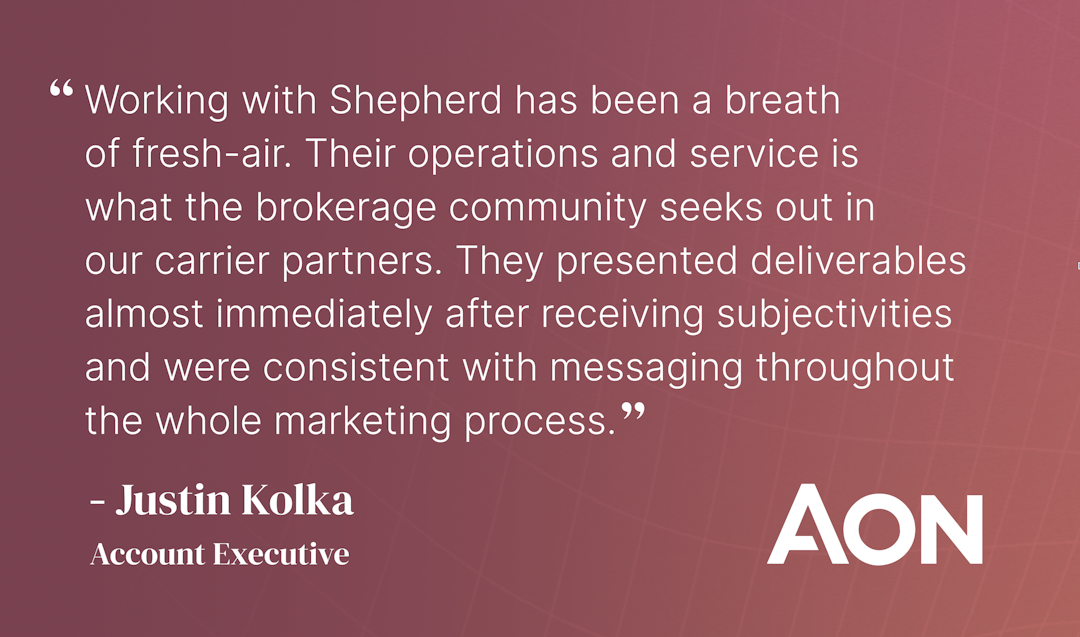Justin Levine
Co-Founder & CEO
July 11, 2022
Into the final days of June, by far our best month on record including eclipsing the $1M premium milestone, I began to reflect on Shepherd’s first 100 days in market. What had we gotten right? What assumptions have already proven to be wrong? What were the biggest surprises? These first hundred days have taught us so much already and have influenced the way we strategize for the future. With feedback from across the team, I’ve compiled the top 3 lessons learned along the way and shed some light on how we’re internalizing them for the next 100 days and beyond.
In the first week that Shepherd was live we received 26 new submissions for April and May opportunities. Our entire plan for the month of March was 10 submissions. We knew the demand for excess capacity in construction was extremely high, but it was still surprising to feel just how eager brokers were to start working with Shepherd. When we’d ask our partners what percentage of their accounts they planned on marketing for excess programs this year the most common response was “all of them.” It was clear that our ability to handle inbound volume efficiently would be much more important than we originally thought. More strategically, we had found something that everyone in the company could rally around.
Typical software companies can focus on annually recurring revenue (ARR) as a measurement for growth and health. Insurtechs (MGA / MGU / Carriers) need to be a bit more careful, as gross written premium (GWP) is not quite the same as ARR. Building a sustainable and profitable insurance program requires the discipline to avoid adding highly volatile business to the portfolio, especially in the earliest months. We’ve walked away from far more premium than we’ve written thus far.
Our attitude towards submissions is simpler, however, and we often say out loud that “no submission is a bad submission”. Every new account is an opportunity to have a meaningful touchpoint with a broker or client partner and to showcase our service model. We decided to formalize Shepherd’s strategy around submissions as a metric rather than GWP. Whether it be underwriters outbounding to brokers directly, or engineers unlocking more efficiency by shipping new features in our platform, the entire company can contribute to growing our submission flow.
The result has been a deep alignment of what success means across our team, and we are fielding far more submissions today than we had ever anticipated. Just as we hoped, the premium growth has followed – and we’re writing the types of accounts that we know will make Shepherd successful for the long term.
In formulating the idea of Shepherd, we always knew that technology would unlock a speed advantage in our underwriting. While other carriers tend to respond to brokers in anywhere from 5 days to several weeks (mostly due to clunky workflows and disconnected internal systems), we promised from the day we launched that every submission sent to Shepherd would receive a written indication back to the broker within 24 hours. For the first 100 submissions we received, the response time from our underwriting team has averaged less than 14 hours. The feedback to this has been overwhelmingly positive. We often receive emails and phone calls like this from our broker partners:

What we’re learning, more importantly, is that speed of response provides our brokers with leverage – the ability to lock in pricing early for a low excess layer and in turn be able to build the remainder of an insured’s excess tower with the hardest parts already secured. In a world where excess programs are filled with upwards of 6 to 8 different insurance providers, the ability to get responses quickly is a significant value for brokers.
Speed is proving to be a critical value prop for repeat opportunities as well. More than 30% of our broker partners have already sent more than one submission to our team, despite our only being live in market for a few short months. This is an early indication that our focus on exceptional service is resonating. Ultimately, brokers want to transact with partners that are a pleasure to do business with – our tech allows us to be high touch and service oriented even while growing inbound opportunities.
In May we formally launched Casualty Pro – an integrated insurance offering for construction tech users. The idea is simple: include your construction tech usage in a submission and we’ll parse the data to apply credits or improve terms on our proposal. Shepherd is creating the incentive for contractors to continue investing in tools that proactively reduce claims and losses. Our first partner was Procore, the leading provider of construction management software with over 14,000 active users. In June, we followed up with OpenSpace, the leader in computer vision software for job site capture.
The response to this program has been met with a lot of excitement across brokers, contractors, and construction technologists. The creation of this program feels long awaited for the early adopters of technology in this industry, with many contractors feeling like they are finally being recognized for the investment, adoption, and improvements that technology has made on their day-to-day risk mitigation efforts across projects. We want to accelerate the adoption and usage of tools like Procore and OpenSpace, because we think they make a significant impact on loss results. But for the Shepherd flywheel to work, contractors need to receive direct financial benefits in order to further their investments in tech.
While Casualty Pro is exciting for many, it’s also quite new and needs a lot of explaining. Common questions we’ve fielded include: is this really a win-win? Can my client be negatively impacted by sharing their technology usage? How big are the benefits and will they move the needle on pricing? The reality is that many brokers are naive when it comes to their contractor’s usage of technology not because they don’t care, but rather because it’s never been a question that insurers have asked before. As a result, we’re spending a lot of our time in these early months educating and connecting the dots for our partners, without being perceived as adding friction to the normal insurance procurement process.
Of course, we knew that the introduction of construction technology data into submissions would be novel. We bound our first Casualty Pro client in June, where the contractor’s usage of Procore significantly impacted our underwriting and allowed us to aggressively win the client’s business. We need to stack these proof points together, create case studies, and continue to evangelize the impact of Casualty Pro. Once brokers and clients catch on, we’ll start seeing the returns on this program in a bigger way.
At Shepherd we are optimists by nature, held together by a collective belief that there is a better way to insure contractors through shared incentives and alignment. In just a few short months, we have learned that we will need to be willing to iterate quickly on goals, double down on what’s working, and continue to push the frontiers of innovative products. These are the early days, but we’re incredibly excited about what we’ve accomplished so far.
Read more from Shepherd
Introducing Shepherd AI Compliance: Advancing Construction’s Insurance Technology
The first offering of Shepherd's free software platform for insureds
Justin Levine
Co-Founder & CEO
February 27, 2024
Announcing Shepherd's $13.5M Series A
Today we’re thrilled to announce Shepherd has raised a Series A financing, led by Costanoa Ventures
Justin Levine
Co-Founder & CEO
February 7, 2024

Any appointed broker can send submissions directly to our underwriting team